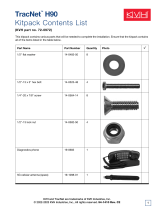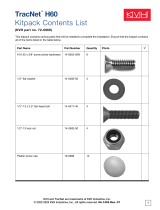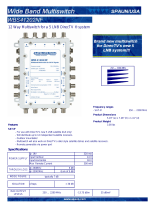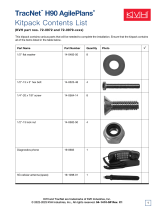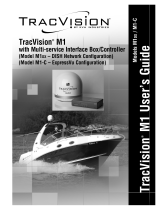Page is loading ...

Satellite Television
KVH TracVision
®
L3/S3
owner’s
manual
•
Installation Instructions
•
User’s Guide
•
Technical Manual
A Guide to TracVision L3/S3

Congratulations!
You have selected one of the most advanced land-mobile satellite
tracking systems available today. KVH
®
Industries’
TracVision
®
L3/S3 is designed for use with European and North
American DVB-compatible satellite services as well as
DIRECTV
®
. This manual provides detailed instructions on the
proper installation, use, and maintenance of your
TracVision L3/S3 system. Before using this manual, be sure to
check the inside back cover for any addenda, which may detail
changes to the manual’s information.
Throughout this manual, important information is marked for
your attention by these icons:
Direct questions, comments, or suggestions to:
KVH Industries, Inc. KVH Europe A/S
50 Enterprise Center Ved Klaedebo 12
Middletown, RI 02842 USA 2970 Hoersholm Denmark
Tel: +1 401 847-3327 Tel: +45 45 16 01 80
Fax: +1 401 849-0045 Fax: +45 45 86 70 77
E-mail: [email protected] E-mail: [email protected]
Internet: www.kvh.com Internet: www.kvh.com
If you have any comments regarding this manual, please e-mail
them to [email protected]. Your input is greatly appreciated!
KVH Part # 54-0157 Rev. G
© 2003, KVH Industries, Inc.
TracVision L3/S3 Serial Number
This serial number will be required
for all troubleshooting or service
calls made regarding this product.
Click here to go to our
state-of-the-art Customer
Support web page...the
fastest and easiest way
to get all of your
questions answered!

TracVision
®
, KVH
®
, and TracNet™ are trademarks of
KVH Industries, Inc.
DVB
®
(Digital Video Broadcasting) is a registered trademark of the DVB Project.
DIRECTV
®
is an official trademark of DIRECTV, Inc.,
a unit of GM Hughes Electronics.
DISH Network
™
is an official trademark of
EchoStar Communications Corporation.
ExpressVu is a property of Bell ExpressVu, a wholly owned
subsidiary of Bell Satellite Services.
DirecPC
®
is a registered trademark of
Hughes Network Systems, a unit of GM Hughes Electronics.

Table of Contents
1 Introduction . . . . . . . . . . . . . . . . . . . . . . . . . . . . . . .1-1
1.1 Digital Satellite Television . . . . . . . . . . . . . . . . . . . . . . . . . . . . . .1-1
1.2 System Overview . . . . . . . . . . . . . . . . . . . . . . . . . . . . . . . . . . . .1-2
1.2.1 TracVision L3/S3 Components . . . . . . . . . . . . . . . . . . . . . .1-3
1.2.2 Integrated Receiver Decoder (IRD) . . . . . . . . . . . . . . . . . . .1-3
1.3 Materials Provided with TracVision L3/S3 . . . . . . . . . . . . . . . . .1-4
1.3.1 Additional Materials Required for TracVision L3/S3 Use . . .1-5
2 Installation . . . . . . . . . . . . . . . . . . . . . . . . . . . . . . . .2-1
2.1 Choosing the Best Location . . . . . . . . . . . . . . . . . . . . . . . . . . . .2-3
2.2 Mounting the Antenna Unit . . . . . . . . . . . . . . . . . . . . . . . . . . . . .2-4
2.3 Connecting System Components . . . . . . . . . . . . . . . . . . . . . . . .2-9
2.3.1 Connecting the Antenna Data/Power Cable . . . . . . . . . . . .2-10
2.3.2 Connecting to Vehicle Power . . . . . . . . . . . . . . . . . . . . . . .2-11
2.3.3 Connecting the IRD Ground Wire . . . . . . . . . . . . . . . . . . .2-12
2.3.4 Installing the Switchplate . . . . . . . . . . . . . . . . . . . . . . . . .2-12
2.3.5 Connecting the Antenna RF Signal Cable to the IRD . . . .2-13
2.3.5.1 Installing Two IRDs and TVs (North American
Systems Only) . . . . . . . . . . . . . . . . . . . . . . . . . . . . . . .2-13
2.3.5.2 Connecting Three or More IRDs and TVs
(North American Systems Only) . . . . . . . . . . . . . . . . . .2-14
2.3.6 Sealing the Cable Access Hole . . . . . . . . . . . . . . . . . . . . .2-15
2.4 Activating the IRD . . . . . . . . . . . . . . . . . . . . . . . . . . . . . . . . . . .2-15
2.5 Selecting the Active Satellite . . . . . . . . . . . . . . . . . . . . . . . . . .2-16
2.5.1 Installing Your Selected Satellites . . . . . . . . . . . . . . . . . . .2-17
2.5.2 Programming User-defined Satellites . . . . . . . . . . . . . . . .2-19
2.6 Setting the Skew Angle (European Systems Only) . . . . . . . . .2-24
2.7 Checking Out the System . . . . . . . . . . . . . . . . . . . . . . . . . . . . .2-25
2.8 Configuring TracVision L3/S3 for Remote
Satellite Dish Operation . . . . . . . . . . . . . . . . . . . . . . . . . . . . . .2-26
2.9 Changing Geographic Location . . . . . . . . . . . . . . . . . . . . . . . .2-27
i
54-0157 Rev. G

ii
3 Using Your TracVision L3/S3 . . . . . . . . . . . . . . . . . . . . .3-1
3.1 Turning On the System . . . . . . . . . . . . . . . . . . . . . . . . . . . . . . . .3-1
3.2 Changing Channels and Switching Between Satellites . . . . . . .3-2
3.2.1 Using the IRD Remote Control to Switch
Between Satellites . . . . . . . . . . . . . . . . . . . . . . . . . . . . . . .3-2
3.2.2 Using the TV/SAT Switch to Switch
Between Satellites . . . . . . . . . . . . . . . . . . . . . . . . . . . . . . .3-3
3.2.3 Using a PC to Switch Between Satellites . . . . . . . . . . . . . .3-4
3.3 Watching Television . . . . . . . . . . . . . . . . . . . . . . . . . . . . . . . . . .3-5
3.4 Internet Access . . . . . . . . . . . . . . . . . . . . . . . . . . . . . . . . . . . . . .3-7
4Troubleshooting . . . . . . . . . . . . . . . . . . . . . . . . . . . . .4-1
4.1 Causes and Remedies for Common Operational Issues . . . . . .4-1
4.1.1 Blown Fuse or Improper Wiring . . . . . . . . . . . . . . . . . . . . . .4-2
4.1.2 Incorrect Satellite Configuration . . . . . . . . . . . . . . . . . . . . .4-2
4.1.3 Satellite Signal Blocked . . . . . . . . . . . . . . . . . . . . . . . . . . .4-2
4.1.4 Dew or Rain Pooling on Dome . . . . . . . . . . . . . . . . . . . . . .4-3
4.1.5 Satellite Coverage Issue . . . . . . . . . . . . . . . . . . . . . . . . . . .4-3
4.1.6 Vehicle Turning During Startup (TracVision L3 only) . . . . . .4-3
4.1.7 Incorrect or Loose RF Connectors . . . . . . . . . . . . . . . . . . .4-3
4.1.8 Type of Multiswitch Used
(North American Systems Only) . . . . . . . . . . . . . . . . . . . . .4-4
4.1.9 Stationary Use Only (TracVision S3 only) . . . . . . . . . . . . . .4-4
4.2 IRD Troubleshooting . . . . . . . . . . . . . . . . . . . . . . . . . . . . . . . . . .4-4
4.2.1 IRD Wiring . . . . . . . . . . . . . . . . . . . . . . . . . . . . . . . . . . . . .4-4
4.2.2 IRD Faulty . . . . . . . . . . . . . . . . . . . . . . . . . . . . . . . . . . . . .4-4
4.3 Antenna Gyro and LNB Faults . . . . . . . . . . . . . . . . . . . . . . . . . .4-4
4.4 Computer Diagnostics . . . . . . . . . . . . . . . . . . . . . . . . . . . . . . . .4-5
4.5 Maintenance Port Parser Commands . . . . . . . . . . . . . . . . . . . . .4-5
5 Maintenance . . . . . . . . . . . . . . . . . . . . . . . . . . . . . . .5-1
5.1 Warranty/Service Information . . . . . . . . . . . . . . . . . . . . . . . . . . .5-1
5.2 Preventive Maintenance . . . . . . . . . . . . . . . . . . . . . . . . . . . . . . .5-1

5.3 Replaceable Parts . . . . . . . . . . . . . . . . . . . . . . . . . . . . . . . . . . . .5-2
5.4 Field Replaceable Unit Procedures . . . . . . . . . . . . . . . . . . . . . .5-3
5.4.1 PCB Removal and Replacement . . . . . . . . . . . . . . . . . . . . .5-5
5.4.2 RF Detector/DVB Decoder . . . . . . . . . . . . . . . . . . . . . . . . .5-6
5.4.3 Antenna Gyro Assembly (TracVision L3 only) . . . . . . . . . . .5-7
5.4.4 Antenna LNB Replacement . . . . . . . . . . . . . . . . . . . . . . . .5-8
5.5 Preparation for Shipment . . . . . . . . . . . . . . . . . . . . . . . . . . . . . .5-9
Appendix A System Specifications
Appendix B Comprehensive System Wiring Diagram
Appendix C Switchplate Template
Appendix D Startup Data Sequence
Appendix E Maintenance Port Parser Commands
iii
54-0157 Rev. G

1 Introduction
1.1 Digital Satellite Television
Your new TracVision L3/S3 satellite antenna is fully compatible
with the Digital Video Broadcasting (DVB
®
) satellites, which use
the international standard for digital TV transmission, as well as
Digital Satellite Service (DSS) services, such as DIRECTV
®
. As a
result, you will be able to receive and decode signals from your
chosen satellite services with the proper programming and
hardware (e.g., the IRD [satellite TV receiver]). Your
TracVision L3/S3 is also fully compatible with KVH’s TracNet
™
2.0 Mobile High-speed Internet System (for more information,
please visit our web site at www.kvh.com).
Your TracVision L3/S3 comes with a pre-programmed “satellite
library” of European and North American satellite services.
When configuring the TracVision L3/S3, you may choose a pair
of satellites from the entire library to be active in the system and
with your IRD. For the antenna to receive signals from two
satellites, they must be within 10º longitude of each other in
orbit. As a result, certain satellites can be paired only with certain
other satellites. Tables 1-1 and 1-2 list the possible satellite pairs
that may be selected in North America and Europe. If the satellite
service you wish to receive is not already in the “satellite library,” you
may also add two additional satellites of your choice to the library.
1-1
Introduction
54-0157 Rev. G
TracVision L3/S3’s default satellite
pairs are:
Europe: Astra 1 & Hotbird
N. America (US DIRECTV):
DSS_101 & DSS_119
or
N. America (US DISH Network):
Echo_119 & None
or
N. America (ExpressVu):
Expressvu & None
Refer to Section 2.5, “Selecting the
Active Satellite,” for instructions on
selecting different satellites.
DSS_101 ✓
DSS_119 ✓
Echo_61 ✓✓ ✓
Echo_110 ✓ ✓✓✓
Echo_119 ✓✓ ✓✓
Echo_148 ✓✓ ✓
Expressvu ✓✓✓✓
DSS_101 DSS_119 Echo_61 Echo_110 Echo_119 Echo_148 Expressvu
Table 1-1
Available N. American Satellite
Pairs (U.S.-style LNB required)

1.2 System Overview
A complete satellite TV system includes the TracVision L3/S3
connected to an IRD and a television set. The optional TV/SAT
Switch allows you to select a satellite at the press of a button. A
desktop or laptop computer is used to configure the system and
conduct diagnostics. The complete system is illustrated in
Figure 1-1.
System specifications and a wiring diagram are provided in
Appendices A and B, respectively.
1-2
A Guide to TracVision L3/S3
11-16 Volts DC
2.5-3.5 Amps
Satellite Receiver 1
RF2
Options Purchased Separately
TV 1
Data/Power
Vehicle
PowerSwitchplate
PC Maintenance
Satellite Receiver 2TV 2 Laptop PC
TracVision Antenna
RF1
Baseplate
Radome
Second TV
and receiver
option only
available with
U.S.-style,
dual output
LNB.
TV/SAT Switch
(optional)
S
a
t A
E
rr
o
r
O
ther Indicators
:
•Bo
th
blinking
green: initia
lizin
g
• Error lig
ht
blinking
red
:
system
pro
blem
C
ha
ng
ing
S
atellite
s:
1.Pu
s
h
S
ele
ct bu
tto
n
2.W
ait w
h
ile
S
at A or
B
blinks g
reen
3.R
eady w
hen
Sat A
o
r S
at B
stays
so
lid g
reen
S
a
t
B
S
e
le
c
t
Figure 1-1
TracVision L3/S3 System
Configuration
If you are a DISH 500 customer,
you can order the optional TV/SAT
Switch – free of charge. Simply fill
out the order form located at the
back of this manual and fax it to
KVH at +1 401 845-8190.
Astra 1 ✓✓ ✓✓
Astra 2N ✓✓
Astra 2S ✓✓
Hispasat
Hotbird ✓✓✓ ✓
Sirius ✓✓✓
Thor ✓
Astra 1 Astra 2N Astra 2S Hispasat Hotbird Sirius Thor
Table 1-2
Available European Satellite Pairs
(European LNB Required)

In-motion Tracking (TracVision L3 only)
The TracVision L3 employs a state-of-the-art actively stabilized
antenna system. Once the satellite is acquired, the antenna gyro
continuously measures your vehicle’s motion and position, and
transmits commands to the antenna motors to keep the antenna
pointed at the satellite at all times.
1.2.1 TracVision L3/S3 Components
The antenna unit includes the antenna positioning mechanism,
signal front end, power supply, and control elements. The
antenna is a parabolic dish mounting a low noise block (LNB)
converter with built-in preamplifier. The European configuration
includes a single-output LNB while the North American system
uses a dual-output LNB. A molded ABS radome encloses the
fiberglass baseplate and is secured in place with standard
fasteners. Connectors on the back of the baseplate join the power,
signal, and control cabling from units inside the vehicle.
1.2.2 Integrated Receiver Decoder (IRD)
The IRD (purchased separately) receives satellite signals from the
antenna unit for signal processing and channel selection, and
sends the signals to the TV set for viewing. The IRD also
provides the interface for the user to activate authorization for
reception. Please refer to the User’s Manual provided with your
selected IRD for complete operating instructions.
1-3
Introduction
54-0157 Rev. G
The dual-output LNB in the North
American systems allows two
IRD/TV pairs to be connected
directly to the antenna.Three or
more pairs can be connected to the
system if an active multiswitch is
used. Section 2.3.5, “Connecting
the Antenna RF Signal Cable to the
IRD,” provides installation directions
for each of these options.
Before you can start watching
satellite TV using your TracVision
antenna, you will need to activate
your IRD. Refer to Section 2.4,
“Activating the IRD,” for more
details.
KVH offers an upgrade kit (KVH
Part #02-1026) that adds in-motion
tracking capability to the
TracVision S3, allowing you to
receive satellite signals while on
the move.

1.3 Materials Provided with
TracVision L3/S3
Table 1-3 lists the units, cables, and materials packed in the
TracVision L3/S3 package by name and KVH part number.
Component KVH Part No.
Antenna Unit (TracVision L3), comprising: 01-0225-19
†
01-0225-22
††
01-0225-25
†††
01-0225-28
††††
Baseplate Assembly (TracVision L3) 02-1245-01*
02-1245-03**
Radome Assembly (TracVision L3) 02-0953-03
Antenna Unit (TracVision S3), comprising: 01-0225-21
†
01-0225-27
†††
01-0225-30
††††
01-0225-24
††
Baseplate Assembly (TracVision S3) 02-1245-02*
02-1245-04**
Radome Assembly (TracVision S3) 02-0953-05
RF Cable (28 ft/8.5 m) 32-0417-28
Data/Power Cable (28 ft/8.5 m) 32-0730-28
PC Cable (6 ft/1.8 m) 32-0628-06
Kitpack*** 72-0101
Owner’s Manual 54-0157
IRD Ground Wire 32-0583-50
Switchplate 02-1023-01
TV/SAT Switch (optional) 01-0245
†
European TracVision L3/S3 system
††
North American TracVision L3/S3 system (defaulted to DIRECTV)
†††
North American TracVision L3/S3 system (defaulted to DISH Network)
††††
North American TracVision L3/S3 system (defaulted to ExpressVu)
* Baseplate assembly with single-output LNB
** Baseplate assembly with dual-output LNB
*** A complete listing of kitpack contents is provided in Ta ble 2-2.
1-4
A Guide to TracVision L3/S3
Table 1-3
TracVision L3/S3 Packing List
Cables for the TracVision L3/S3 are
stored beneath the antenna unit
during shipping.

1.3.1 Additional Materials Required for
TracVision L3/S3 Use
To make full use of your new TracVision L3/S3 and receive
satellite TV on the road, you will need to provide/purchase the
following:
• Television
• Appropriate IRD for your selected satellite
TV service
1-5
Introduction
54-0157 Rev. G
In North America, you can
purchase and/or activate an IRD
directly from KVH. Call KVH at
1-888-584-4163 for details.

2-1
Installation
54-0157 Rev. G
2 Installation
TracVision L3/S3 is designed for simple installation and setup.
Just follow these easy steps:
Step Refer to Section...
1. Choose the hardware locations 2.1
2. Mount the antenna unit 2.2
3. Connect system components 2.3
4. Activate the IRD 2.4
5. Select active satellite 2.5
6. Set the skew angle (Europe only) 2.6
7. Check out system 2.7
8. Configure for remote dish use 2.8
Tools and Materials Required
• Electric drill
•
3
⁄16" (5 mm),
5
⁄32" (4 mm), and
3
⁄32" (2.5 mm) drill bits
and
3
⁄4" (19 mm) hole saw and auger bit
•
1
⁄
2" wrench
• #2 Phillips and #0 flat tip screwdrivers
• RG-6 or RG-11 (75 ohms) RF cable (if installing
two RF cables - refer to Section 2.3.5 for details)
• Silicone sealant, RTV, or Sikaflex
•
7
⁄
16" open end wrench
• Construction adhesive (e.g., Liquid Nails)
• Rivet gun and
3
⁄16" (5 mm) rivets (or other fastener
suitable for your specific roof construction)
• PC with terminal emulation software such as
PROCOMM or Windows Terminal or
Hyperterminal
Plan the entire installation before
proceeding! Take into account
component placement, cable
running distances between units,
and accessibility to the equipment
after installation.
Table 2-1
Installation Process

2-2
A Guide to TracVision L3/S3
Kitpack Contents
Table 2-2 lists the materials provided in the kitpack.
Part Qty. KVH Part No.
Tie-wraps 5 22-0013
Clamshell ventilator 1 19-0230
#6 x
3
⁄4" thread-forming screws 3 14-0298-12
1
⁄4"-20 x
5
⁄8" hex screws 4 14-0250-0010
1
⁄
4" flat washers 4 14-0251
Switchplate bulb assembly (spare) 1 19-0193
3
⁄8" hole plugs 2 19-0282-06
Table 2-2
Kitpack Contents

2-3
Installation
54-0157 Rev. G
2.1 Choosing the Best Location
• Since the TracVision antenna requires a clear view
of the southern sky to receive satellite signals, the
ideal antenna site has an unobstructed view of the
horizon/satellite all around.
• Keep the antenna clear of any obstructions on the
roof (e.g., air conditioners). The antenna requires a
15º to 75º look angle to receive satellite signals.
• Consider the location of the antenna relative to the
location of any equipment or necessary wiring
within the vehicle.
• Be sure to mount the antenna on a horizontal
surface. When placed flat on the mounting surface,
the mounting plates should be less than
7
⁄
16" above
the mounting surface (see Figure 2-2). Any larger
gap will warp the baseplate and seriously damage
the antenna.
Blocked!
TracVision Antenna
Air Conditioner
Vehicle Roof
Figure 2-1
Antenna Blockage
" Maximum Gap
7
16
Figure 2-2
Maximum Mounting Surface Slope

2-4
A Guide to TracVision L3/S3
2.2 Mounting the Antenna Unit
1. Make sure that you have chosen a suitable
mounting location based upon the guidelines in
Section 2.1, “Choosing the Best Location.”
2. Remove the antenna unit from its shipping carton.
3. Position the antenna unit in the desired location
on the centerline of the vehicle with the antenna’s
mounting plate arrows facing the front or rear of
the vehicle. The proper orientation is illustrated in
Figure 2-3.
4. While the antenna is in place, mark a location on
the roof for the
3
⁄
4" (19 mm) cable access hole to
permit convenient cable access to the antenna’s
baseplate connectors.
5. Using the 4 mounting plates and each set of 5
holes as templates, drill 20
3
⁄16" (5 mm) holes
through the roof of the vehicle.
6. Set aside the antenna unit and clean the roof’s
surface to remove any debris.
Always lift the antenna unit by the
gray baseplate, never by the
radome or any portion of the
antenna assembly!
The mounting plate arrows may
face either forward or backward
along the centerline of the vehicle
for more convenient installation.
Vehicle
Centerline
Vehicle
Centerline
Front/Rear
of Vehicle
Front/Rear
of Vehicle
Top View Side View
Mounting Plate
(1 of 4)
Baseplate
Connectors
Mounting Plate
Arrows
Figure 2-3
Proper Orientation of
the Antenna Unit

2-5
Installation
54-0157 Rev. G
7. Seal the two baseplate holes shown in Figure 2-4
with the plugs provided in the kitpack.
8. Apply construction adhesive to the bottom of the
antenna’s four mounting plates. If using a liquid
construction adhesive, apply beads to the
mounting plates in a zig-zag pattern.
9. Reposition the antenna, lining up the mounting
plate holes with the holes in the roof. Attach the
mounting plates to the roof using
3
⁄16" (5 mm)-
diameter rivets (or appropriate fasteners). Seal all
rivet heads and edges with silicone.
10. Remove and save the 8 pan head screws and flat
washers that secure the radome to the baseplate.
Carefully lift the radome straight up until clear of
the antenna assembly and set aside.
11. When the antenna unit is installed with the
connectors facing the rear of the vehicle, the drain
holes are located as shown in Figure 2-5.
Figure 2-5
Baseplate Connectors Facing Rear
of Vehicle – Factory-drilled
Drain Hole Locations
If the roof’s mounting surface is not
perfectly flat as KVH recommends,
make sure the baseplate does not
warp when you attach the
antenna’s mounting plates. Refer to
Section 2.1, “Choosing the Best
Location,” for further details.
Factory-drilled
Drain Hole Positions
Front of
Vehicle
Figure 2-4
Antenna Baseplate (Bottom View)
Baseplate Holes

2-6
A Guide to TracVision L3/S3
12. Cut the tie-wraps holding the antenna unit to the
forward shipping restraint (see Figure 2-7).
Figure 2-7
Forward Shipping Restraint
(Arranged for Shipping)
Figure 2-6
Baseplate Connectors Facing
Front of Vehicle – Recommended
Drain Hole Locations
Yo u MUST drill out the drain holes
as indicated to ensure that any
moisture that enters the baseplate
is able to drain. Ensure that factory-
drilled holes are completely sealed.
11a.(Alternate Drain Hole Locations) If the antenna unit
is installed with the connectors facing the front of
the vehicle, drill out
3
⁄16
" (5 mm)-drain holes in the
rear-facing side of the baseplate as illustrated in
Figure 2-6. The existing factory-drilled drain
holes shown in Figure 2-5 must then be plugged
with silicone rubber sealant.
Recommended
3/16" (5 mm)
Drain Hole Positions
Drain Hole Angle
(relative to baseplate)
Front of
Vehicle
Angle of Hole, relative to front
Angle of Hole, relative to front

2-7
Installation
54-0157 Rev. G
13. Remove the nuts and washers securing the
shipping restraints to the baseplate. The positions
of all three shipping restraints are pictured in
Figure 2-8.
14. For convenient storage, rotate the shipping
restraints 180º and secure them to their original
mounting bolts using the nuts and washers
removed in Step 13 (see Figures 2-9 through 2-11).
All nuts and washers removed in Step 13 must
be reinstalled. These nuts and washers secure the
baseplate to the mounting plates.
Installation Bolt and Washer
Rotating Plate Shipping Restraint (1 of 2)
Figure 2-10
Rotating Plate Shipping
Restraint Storage
Rotating Plate
Shipping Restraint
Rotating Plate
Shipping Restraint
Forward Shipping
Restraint for
LNB Bracket
Figure 2-8
TracVision L3/S3 Shipping
Restraints (Top View,
Installed for Shipping)
Do not discard the shipping
restraints, washers, or the nuts.
They should be stowed for future
use in case the antenna unit needs
to be removed and shipped to
another location. Four
1
⁄4˝ x
5
⁄8˝ hex
head screws have been provided in
the kitpack for shipping as the bolts
used to hold the shipping restraints
during initial shipping are integral
parts of the mounting plates.
Forward Shipping Restraint
Installation Bolts and Washers
LNB
Figure 2-9
Forward Shipping
Restraint Storage

2-8
A Guide to TracVision L3/S3
15. Place the radome onto the baseplate (labels facing
the sides of the vehicle) and secure in place using
the 8 pan head screws and flat washers removed
in Step 10.
16. Drill the cable access hole (marked in Step 4) in the
vehicle’s roof.
Figure 2-11
TracVision L3/S3 Shipping
Restraints (Storage Position)
Forward
Shipping Restraint
Rotating Plate
Shipping Restraint
Rotating Plate
Shipping Restraint

2-9
Installation
54-0157 Rev. G
2.3 Connecting System Components
The following sections provide instructions for properly wiring
the antenna unit to the components inside the vehicle.
Locating the Switchplate
A switchplate has been provided to serve as the hub of the
TracVision L3/S3 wiring (with the exception of the RF cable,
which will be connected to the IRD). This switchplate includes an
ON/OFF switch and a DB9 maintenance port for easy access to
the antenna unit’s software and diagnostics. Follow the steps
below to select and prepare the switchplate mounting location.
1. Select a location to mount the TracVision L3/S3
switchplate. It should be installed in a dry, flat
location within reach of the cables that will
connect to the antenna unit.
2. Once you’ve decided on a suitable location, create
a panel cutout in the mounting surface.
Figure 2-12 illustrates the mounting dimensions
and a template has been provided in Appendix C.
The connecting cables will be routed through this
cutout.
3.82"
(97 mm)
.32" (8 mm)
2.36"
(60 mm)
.16" (4 mm)
3.19"
(81 mm)
2.05"
(52 mm)
Panel Cutout
3
/32" (2.5 mm) dia
Figure 2-12
Switchplate Panel
Cutout Dimensions
A full-scale panel cutout template
has been provided in Appendix C.
/
